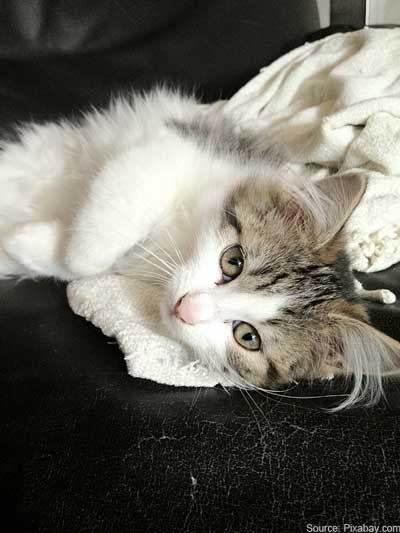If you lovingly share your household with a pet (whether you've just moved to a new house or remain in your current home), you’ll want to do everything you can to make the environment safe and enjoyable—not to mention durable and easy-to-clean! The following tips and suggestions will help you create the optimal home for you and your pet to share harmoniously.
Put up a fence

Make sure your pet doesn’t get loose by building a tall, secure fence around your property. This is especially important if you own a dog that will be outside without your supervision. It isn’t fair to tie your dog up in your backyard to keep him restrained—he should have free reign of your property to run and play. You should also ensure that the fence is high enough that your dog can’t jump over it, and deep enough into the ground to prevent him from digging himself out. You can also install pavers along the fence or pour cement to deter larger dogs from digging. Avoid electric fences or those with sharp edges that can cause injury.
For outdoor cats you would prefer not to roam, there are now special cat fences designed to keep kitties within your property’s boundaries. Flexible material and a difficult-to-scale arch will keep even the most acrobatic cats inside your yard.
Provide a sleeping area
Your pet should have a designated sleep space where she can feel safe, comfortable and secure. This may also limit her tendency to jump and sleep on the furniture, preventing damage from her claws or copious amounts of hair accumulating. Pet beds come in an array of shapes and sizes to accommodate your pet’s needs. Crates work well for larger dogs, especially those with aggression issues. Small, fleece-lined beds are perfect for kitties to curl up, and giant pillow beds are good for dogs that like to sprawl out. If your pet likes to be secluded, consider turning a closet into your pet’s private sleep den.
Keep hazardous items secure
Ensuring your pet’s safety is the most important part of maintaining a pet-friendly household. Stow medications, cleaning supplies, and other hazardous chemicals in hard to reach places or in securely locked cabinets. Keep your trash can under the sink so it is inaccessible to nosy pets—you may require child-safety locks on the cabinets as well if you have a particularly resourceful pet. Be vigilant in retrieving dropped pills or foods that are toxic to pets.
Use pet-friendly cleaning products
Even if you keep your household chemicals safely out of your furry friend’s reach, the substances will cover every surface of your home if you use them to clean. Harsh cleaning products will get on your pets paws and fur, become ingested when they groom themselves or eat treats of the floor. Consider opting for all-natural, non-toxic cleaning supplies instead, such as those free of ammonia, chlorine, bleach, paraben and phosphates. There are numerous green cleaning brands on the market, or you could simply
concoct your own solutions with household products like baking soda, vinegar, lemon, and corn starch.
Choose the right flooring
To avoid the wear and tear and keep your home looking great, it’s important to fill your home with pet –resilient materials. Flooring materials in a pet household should be stain-proof and easy to clean, such as:
• Tile
• Vinyl
• Laminate
• Sealed concrete
• Sealed stone.
• Porcelain or ceramic tile
Carpeting collects pet hair and dander, stains easily, and can be difficult to clean. You can limit the stains and damage to your carpeting by adding throw rugs and runners in high-traffic areas that you can easily vacuum, wash, or replace. You can also add rubber mats at your home’s entrances to keep your pups from tracking mud and other outdoor gunk around the house when they come inside.
Keep your pets’ dining and potty areas tidy with a large, absorbent rubber mat under food dishes and litter boxes.
Protect your furniture
Shielding your furniture from sharp claws and excessive pet hair will keep it looking new and pristine—no matter how often your furry friends snuggle

up next to you. The type of furniture best suited for your home will depend on your pets and their habits:
•
Leather furniture is susceptible to scratches and punctures, but it is the easiest material to clean when it comes to fur and dander. If your pet is well-trained and not allowed to jump on the couch or chairs, leather may be easier for you to maintain.
•
Microfiber is a popular fabric used in furniture manufacture because it is durable, comfortable, and resilient to stains.
•
Slipcovers are a great option to protect upholstered furniture from claws. Canvas fabrics are durable and easy to clean. You could also simply toss comfy throws over your pet’s favorite furniture pieces to limit the spread of hair.
•
Wood furniture is easily damaged in a home with pets. Cats and dogs may scratch or chew on wood table or chair legs, leaving unsightly gashes. Metal, glass, and stone are more resilient and less tempting for pets to claw or chow down on.
Provide toys and recreation
Your pet gets bored just like you do—a pet-friendly home is one that allows your pet to exercise, play and have fun. Keeping plenty of your pet’s favorite toys on hand is a start, but there are endless creative ways to transform your home into an exciting play land for your pet.
•
Window seats. Indoor cats love to watch the world go by from the safety of your home. Installing roomy window perches for your cat to gaze at the birds and frolicking squirrels will keep your inside-only kitty plenty entertained.
•
Vertical play. Make use of the vertical space in your home with cat trees, shelves, and other perches that allow your cat to explore new heights in your home—without breaking your valuables! Supplying your cat with the freedom to roam your home vertically helps him feel more in control, regulates bad behavior, and will certainly make him less likely to jump into places where he doesn’t belong out of boredom.
•
Outdoor accommodations. While your dog may love to run around your yard, building her a small enclosure to rest or retreat with her toys will certainly keep her happy. Make sure the dog house is well-insulated and large enough for your dog to stand up, sit down, and turn around.
If you’re a cat person, there are also plenty of enclosed options to give your kitty a taste of the outdoors. Screened-in enclosures can be installed on your porch or property to allow your kitty some fresh air without fear of her getting loose.